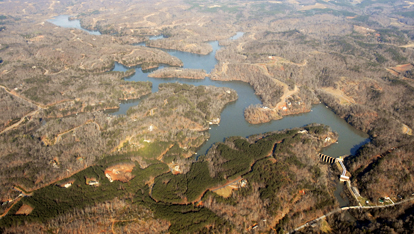From Catawba Power to Duke Energy
Published 3:07 pm Wednesday, February 2, 2011

Aerial view of Lake Adger, showing the dam and power plant on the bottom right. (photo by Chris Bartol)
PCHA looks at history of power in Polk County
Electricity came to Polk County over multiple decades with some incorporated areas receiving power in the early 1900s and other rural areas not receiving electricity until the 1950s.
The Polk County Historical Association presented a program Tuesday, Feb. 1 reviewing the history of power companies in the area.
Calvin Bradley, who retired from Duke Power after 43 years, reviewed the history of companies such as Southern Power Company, Duke Power (now Duke Energy), Blue Ridge Power Company, Broad River Electric Company and Hendersonville Light and Power.
Most power companies began in 1900 or before in order to supply textile plants with power.
Blue Ridge Power Company, which built Lake Adger and the dam for a hydroelectric power plant around 1925, built substations in Landrum, Tryon and Saluda prior to building Lake Adger. Tryon, Landrum and Saluda received substations off a line that Blue Ridge ran from the Tuxedo plant at Lake Summit to Spartanburg, S.C. The Tuxedo plant was in operation in 1918.
More rural areas in Polk County, however, did not receive electricity until the 1950s.
Bradley reviewed the history of electrical plant founders such as William Church Whitner and Dr. Walker Gill Wiley.
The Catawba Power Company began in 1900 when Wylie and his brother financed the building of a hydroelectric power station at India Hook Shoals along the Catawba River. When more funding was needed, Wylie sought the help of James Buchanan Duke to invest in the Southern Power Company, founded in 1905, which later became known as Duke Energy.
The founders of the Blue Ridge Power Company wanted to supply cheap electricity for their textile plants in Spartanburg, S.C., so they planned to build three dams on the Green River. It was to be a $1 million project. Blue Ridge built Lake Summit in Henderson County and a dam in 1916-1917. The flume was made of wood at the time because metal could not be obtained due to World War I, Bradley said. It was at this time that Blue Ridge built lines from Tuxedo (Lake Summit) to Spartanburg and built substations in Landrum, Tryon and Saluda. The Tuxedo plant was opened in 1918 and proved to be very successful, Bradley said.
The other dam was to be built at Turner Shoals, or what is known today at the Lake Adger dam and power plant. Lake Adger was named after one of Blue Ridge Power Company’s founders, John Adger Law. “Adger” was Law’s mother’s maiden name.
Blue Ridge decided to hire a group of surveyors in order to acquire land for the lake and they were “ruthless,” according to Bradley.
“They told residents you sell your land for what we offer or we’ll condemn it,” said Bradley. “Poor farmers couldn’t afford to take them to court. They (Blue Ridge) bought hundreds of acres more than they needed. There was resentment towards the power company up into the 1950s.”
Bradley also said there was resentment by Polk County residents because it was always said the power company covered family cemeteries in the process. This has never been proven, Bradley said, to his knowledge.
A drought shortly after the Turner Shoals plant was built caused Blue Ridge to not have enough power to supply their Spartanburg textile plants in addition to the customers the company had picked up along the way.
Blue Ridge sold their complete system to Broad River Electric Company in 1926.
In 1927, Southern Power reorganized and changed their name to Duke Power Company. Broad River then sold after financial problems to Duke Power.
Duke Power later changed to Duke Energy after merging with PanEnergy in 1997.
Northbrook now owns the power plant at the Turner Shoal’s dam and sells power to Duke Energy. Polk County purchased Lake Adger as a future water source in 2009 for $1.6 million.
More than 50 area residents attended the Polk County Historical Association’s presentation Tuesday with questions and comments given about the history of electricity in the area. Historical Association President Anna Conner said when her father approached Duke Power to get the company to run lines in his area just outside Columbus, he was told if he would purchase a refrigerator, they would run lines, which he did. Another resident who attended the meeting said she remembers having electricity in the 1940s and it cost $5 per month.
Bradley, who lived on Silver Creek Road in Mill Spring, said he didn’t receive electricity until the 1950s.





